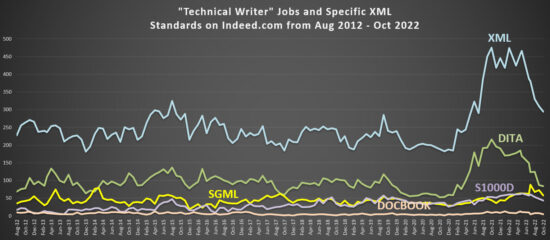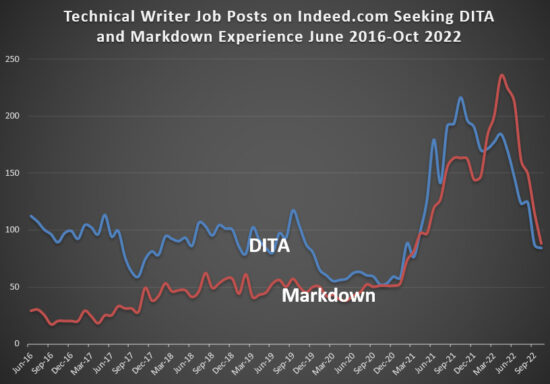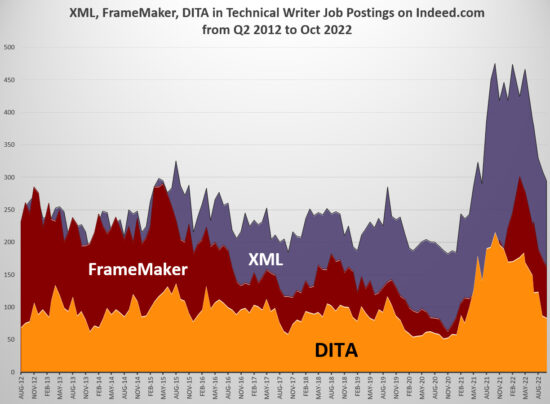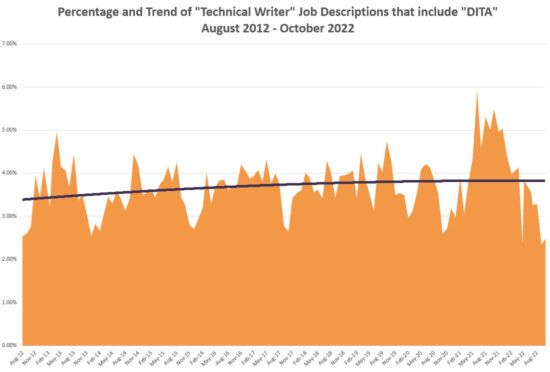
I don’t want to seem all doom and gloom, especially after the previous post on technical writing jobs in general, but I want to talk about some interesting trends that I am seeing. And one of those is a distinct drop in job postings for technical writers with DITA experience. Right now, they account for just 2.5% of all technical writers. While this percentage has never been high (roughly 3.5%-4% has been more typical), it is accompanied by some interesting growth in other areas, such as an increase in job posts seeking Markdown and (separately) FrameMaker experience. Together I think these new statistics tell an interesting story about recent industry trends in technical writing.
More Demand for those with XML Experience
It appears as though structured authoring has engineered at least one fundamental change in technical writer job postings over the years: a general understanding that knowing something about XML is a good thing. What’s interesting is that the number of jobs that are seeking technical writers with XML experience is well above that of any of the structured formats that use XML, even taken collectively. Here’s what technical writer job postings asking for “XML” and “DITA” experience have looked like over the past ten years.

Whether a job is looking for experience with some form of XML or not—often these jobs are paired with mentions of the other standards, such as DITA—it seems that some sense that structured content is a useful skill when searching for technical writers.
Side note: While the DocBook standard would appear to be at the bottom, its use likely goes under-represented given CCMS software like Paligo, which is based on that standard but manages to “hide” it under a very user-friendly graphical user interface. CCMSs in general, rarely get a specific mention in technical writer job postings. Every month the total of individual CCMSs that get mentioned—such as Heretto, Ixiasoft, or Adobe Experience Manager—typically amounts to less than the number of fingers on a single hand per CCMS. (An interesting recent exception to this is Paligo, which typically gets mentioned for the number of fingers on two hands every month).
The precipitous drop seen above in job posts mentioning XML is more to do with the recent downtown of the economy and the associated drop in companies looking for new hires.
But there are other signs that structured authoring is no longer in the ascendant.
More Calls for Those with Markdown Experience
While the overall numbers are not huge, it is noteworthy that technical writer jobs calling for experience with Markdown has surpassed that of DITA. This has been a long time coming. While Markdown as a standard pre-dates DITA, it has come to the fore recently with software documentation. It’s worth pointing out that this is also the area where DITA first came to the fore, so what we see below is an interesting trend.

While not depicted here, there has been a similar rise in the number of technical writer job postings calling for experience with GitHub, which often goes hand-in-hand with Markdown usage.
When I ask people how Markdown has become more prominent, one of the stories I keep hearing is a change in Computer Science courses emphasizing the use of Markdown over that XML. This preference gets pushed from those coding the programs to the technical writers on their staff, so this gradual emphasis on Markdown over DITA has been expected.
FrameMaker Bounces Back
This was a trend I was not expecting: Adobe FrameMaker coming back into its own. For much of the past decade, this venerable technical writing tool has seen a general and seemingly unstoppable decline in mentions within technical writing job posts. I have been using it as a yardstick in measuring the popularity of DITA for some time. But no longer. This is what I see these days:

I think what we see here is the fact that FrameMaker has undergone a significant makeover in the past few years. Just over a decade-and-a-half ago, it was almost abandon-ware, with few updates and lots of bugs—it was this that started me on my road to DITA as the documentation team I was with was casting about for some other solution for their needs.
But that was then, and this is now. FrameMaker has undergone several significant revamps since then, including the ability to incorporate DITA content. But probably the most important development is its integration with Adobe’s CCMS, Adobe Experience Manager, which first happened in 2019. My understanding in talking with others in the industry is that it is still the tool of choice for small one- or two-person technical writing teams, and much of the recent surge in technical writing jobs has come from smaller firms.
Kudos to Adobe for making a tool founded in the 1990s still relevant to today’s technical writers.
Has DITA Plateaued?
The final thing I want to cover here is the fact that DITA has been on a gradual decline recently, at least when it comes to technical writer job postings in the U.S. While adoption rates have never been higher than 6% nationwide, current mentions of DITA in technical writer job postings hovers at roughly 2.5%, and appear to have plateaued. Here’s what that data looks like over the past decade:

As you can see, there has been a lot of variability in the percentage of mentions of “DITA” in technical writer job postings in the States, typically hovering between 3.5% – 4.0% of all such job postings. There appear to be regular season variations in these numbers, with dips coming most years at the end of each year. But even considering that of late, there has been a precipitous drop—much of which is due to the downward trend of job postings in general, but to low levels never seen before. It’s too early to say that DITA has plateaued when it comes to job postings, but it is something I plan to keep an eye on and will report on in the future.
Troubled Times for Structured Authoring?
There’s a perennial problem regarding structured authoring versus unstructured authoring: it takes more time and expertise to create structured content rather than unstructured content. Make no mistake, there are numerous advantages to creating structured content, including more efficient reuse, lower localization costs, multi-channel publishing, and better integration with new and upcoming technologies such as chatbots and artificial intelligence. But typically, it is only larger companies that can fully realize the benefits of structured content formats like DITA. While it is certainly possible for small DITA-based technical writing teams to create content more efficiently and gain significant cost savings from localization, there is always the pressure to simplify and to “just get things done and out the door.” “Word” (as in “MS Word”) is still the most popular term that comes up in all technical writing jobs, and I suspect the recent rise in Adobe FrameMaker (still the tool of choice for smaller technical writing teams) and Markdown may be an early indication of an industry shift away from structured authoring to unstructured.
Is DITA dead? Far from it, as there are a lot of large firms that have made a significant investment in the standard and tooling to gain the efficiencies and cost-savings that it delivers. But those firms are not hiring technical writers in the same volume as they used to. Much of this is due to the recent economic downturn, but as we have seen, there are some other interesting statistics out there suggesting that unstructured content may be coming back to the fore. Only time will tell, and I plan to report on these trends in future articles here on DITAWriter.com.
If you want to hear more about my thoughts on the technical writer job postings, check out the recent interview I did with Scriptorium’s Sarah O’Keefe, published as their Jobs in techcomm (podcast).

One thought on “Has DITA Plateaued?”
Comments are closed.